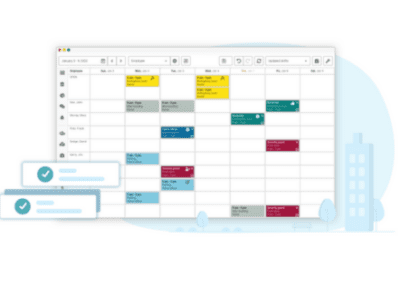Overtime has been a much-debated topic in the world of workforce management for decades now. To some employees, it is a way to bolster their earnings or earn promotions. For others, it is a fast-track ticket to burnout and a decline in productivity. For some employers, it’s a quick fix to broader staffing issues, and to others, it is an unnecessary expense. Shockingly, at least 134 countries have laws setting the maximum length of the workweek; the U.S. does not. This sets a pretence to understanding how big the problem is for the U.S workforce.
What is Overtime?

Overtime refers to hours worked by employees that exceed their normal working hours. Generally, the term also refers to the remuneration that employees receive for working such hours.
Schedulers often overlook the dangers of overtime. However, when viewed in the cold light of day it’s startling just how costly they can be. Not only can it negatively affect your bottom line, but it can have harmful effects on your staff.
From a strategic point of view, overtime has the potential to seriously damage your long-term success. In fact, it is very much a short-term solution for a larger problem. Studies have shown that people who work over 60 hours per week experienced a 25% decline in overall productivity. Not only is productivity affected, but overtime obviously increases costs significantly.
Rather than planning for predictable profit, dysfunctional scheduling can lead to extensive overtime hours for staff. In turn, this leads to an unnecessarily higher payroll. In this regard, staff putting in extra hours per week acts as a “quick fix” to complete important tasks. However, this only serves to mask a serious problem.
134 countries have laws setting the maximum length of the workweek; the U.S. does not.
Dangers of Overtime
Financial Impact
While it’s hard to know just how much the U.S spends on overtime every year, we know it’s a lot. The Fair Labor Standards act states that “unless exempt, employees covered by the Act must receive overtime pay for hours worked over 40 in a workweek at a rate not less than time and one-half their regular rates of pay”. According to OECD stats, U.S. workers work an average of 1,767 hours per year. However, the OECD country average is 1,687. Therefore we can assume that the majority of employees work overtime, and must be compensated at above their normal rate. Paying employees overtime rates to work unnecessary hours is the pitfall of many employers. Before they know it, their bottom-line is deeply affected.
Impact on Performance

Overtime is not just detrimental in a monetary sense, however; the more visceral effect is in your staff performance. J. Nevison studied the negative effects of overtime on performance. In his white paper, Nevison finds that little productive work takes place over and above 50 hours per week. Two other studies, also examined in the white paper, show that productive hours drop by an additional 10 hours when the number of consecutive long workweeks increases from four to 12, highlighting the cumulative effects that overtime can have. When you consider the financial costs alongside the declining productivity of employees, the costs of overtime become even larger!
Increased Health Problems
If the financial and productivity impact of overtime isn’t enough to turn you off overtime, the effects on your staff should be. Countless studies have linked poor work-life balance and being overworked to health issues. One study focused on people who worked three or more hours longer than a normal, seven-hour day. They actually had a 60% higher risk of heart-related problems such as death due to heart disease. Other health issues associated with overtime include high blood pressure, lower back problems, increased mental health issues, and increased alcoholism and addiction issues. These health problems bring with them other issues for any organization; higher rates of absenteeism as well as increased employee turnover.
Here at Celayix, we work to help organizations remove any unnecessary overtime from their schedules. We’ve helped companies save over $100,000. With over 20 years of experience, we’ve refined the steps that you can take as an employer to reduce overtime scheduling and save money.
Review your Scheduling Process
Overtime is a considerable factor when it comes to employee scheduling. When employee schedules are disorganized, management and staff struggle to accurately match staffing levels to work demand. If you can’t organize staff according to demand, overtime is very likely to occur when demand spikes.
If you’re currently scheduling your employees using pen & paper, or excel, it can be hard to visualize where overtime is/isn’t required. With intelligent scheduling software, you can schedule employees based on whether they will go into overtime or not. This allows your business the freedom and supports it needs to create and maintain an orderly and cost-effective schedule.
Treat Overtime as the Exception, Not the Norm
Once the habit of scheduling overtime has formed, it can be hard to get out of that cycle. Businesses become accustomed to certain levels of overtime and stop looking at it as a problem. All schedulers should think of it as a last resort, and scheduling overtime should be discouraged where possible.
An effective way to manage this is to set limits on the amount of overtime that can be scheduled for any period. Dig into the numbers and determine an annual cap of overtime hours your business can afford to pay per employee. Finding the balance so that employees can pitch in and work more overtime but not too much where overtime begins to feel common is the secret to success. Capping overtime ensures that work gets distributed more evenly amongst your team and that everyone has a chance to work overtime hours if they’d appreciate the extra pay.
Clarifying Employee Availability
When scheduling your staff, it helps to know if they’re unavailable. It’s surprising the amount of overtime that can be caused by vague staff availability and miscommunication.
When manually setting schedules, it can be an error-prone and time-consuming process. Trying to figure out if employees are available and whether they can accommodate your scheduling needs is not always easy. Not to mention, it’s a clear illustration of why overtime can reach profit-diminishing levels. Easily accessible information on availability and time off requests provides much-needed clarity, decreasing overtime and keeping both timekeepers and staff happy.
Cross Train your Employees
Depending on your industry, it is often possible to cross-train employees. Take hospitality, or events for example; having all of your servers trained in bar service could save you a lot of money. Rather than scheduling an extra bar server “just in case”, you can pull staff from other departments to handle busy periods as needed.
Not only will your schedules become more efficient in general, but you will likely save your “stronger” employees from working excessive overtime. If you only have certain staff members that are trained in certain tasks, naturally they will end up picking up the slack, and extra shifts.
Labor Forecasting
Typically, overtime arises in two scenarios; poor scheduling, or when demand outweighs labor. Some organizations have known busy periods where demand will rise or spike, such as Christmas or summer. Demand often also rises during periods of high growth. These high demand periods are great, they mean higher profits, right? Well not if you are funneling those new profits into paying overtime for staff to match the demand. To be clear, we’re not saying you need to hire more staff either, there is an alternative!
The key to effective scheduling and eliminating overtime is being able to match staffing to demand through labor forecasting. At its simplest, effective scheduling ensures that you have enough staff when demand is high, and that you’re not overstaffed when business is quiet. By using scheduling software that has a labor forecasting tool, you will better equipped to handle fluctuating demand without clocking up the overtime. Celayix’s labor forecasting tool allows you to create shift ratios to ensure that you always have the right amount of staff to match the amount of customers/clients. You will quickly see how effective labor forecasting can be to curb overtime hours, as you stop overstaffing and shifts are more evenly distributed.

Official Overtime Policy
Following all of the above steps is great, but likely won’t mean much until you make it official. An official overtime policy should cover all of the steps you will be taking to reduce overtime and more. The policy should also detail how you plan to compensate overtime hours while adhering to legal requirements. Include any information around new rules and policies you are putting in place, so that both employees and schedulers are aware. Within the policy, you should also clarify who would approve any overtime hours, and how much choice employees have in the matter.
Creating this policy is one thing, but it is critical to distribute it to all employees and managers in order to set expectations on how overtime will be managed moving forward. Communicate openly with everyone involved with how you plan to help them manage the new policies and abide with new restrictions on overtime. The beauty of creating an official overtime policy for your business means you can tailor it to fit your needs and set the boundaries where they work best for you.
Celayix has been helping companies reduce unnecessary overtime for over 20 years, and we can do the same for you. Our easy-to-use, comprehensive employee scheduling software can help you refine your scheduling process, optimize your schedules and save time. If you’d like to dig deeper into how we can help eliminate unnecessary overtime from your schedule, take a look at our Rules based scheduling engine. If you’d like to talk to a Solution Advisor about saving money on overtime, just get in touch!





